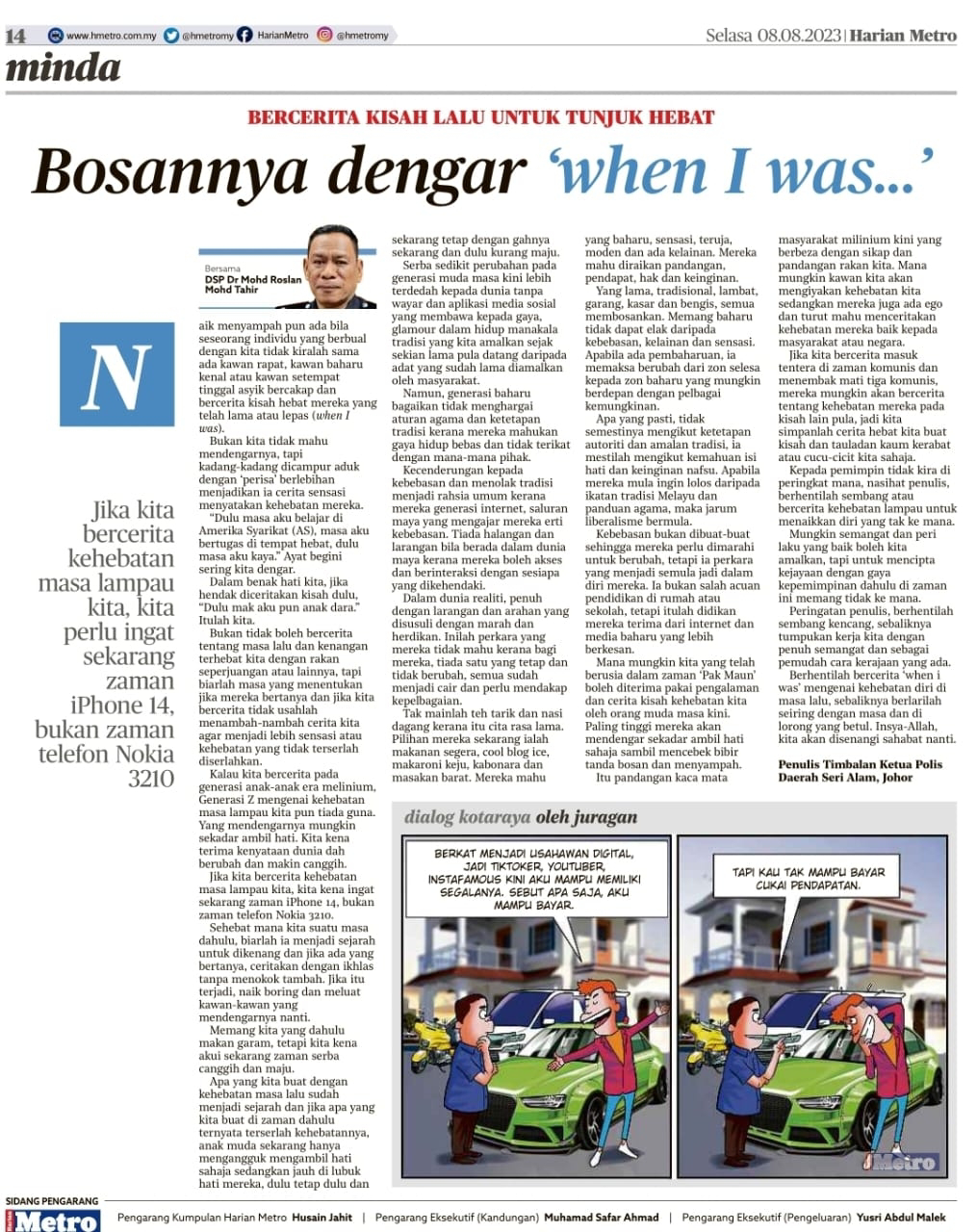Wednesday, 30 August 2023
[30082023] Habit 3: Put First Things First
[30082023] The Art of Strategy: Balancing Transparency and Secrecy
As an education leader, you're entrusted with the responsibility of guiding your institution towards success. At the heart of this journey lies your strategy – a carefully crafted roadmap that defines your approach, goals, and tactics. But when it comes to sharing your strategy, where should you draw the line between openness and secrecy? In this blog post, we'll explore the strategies that should be made known and those that are best kept as secrets.
The Power of Shared Strategy
Vision and Mission Alignment: One aspect of your strategy that should be openly shared is your institution's vision and mission. When your team, students, parents, and stakeholders understand these foundational elements, they can align their efforts and support towards a common purpose.
Broad Goals and Objectives: Sharing high-level goals and objectives helps create a sense of direction and unity. When everyone knows where you're headed, they can contribute more effectively to achieving those goals.
Collaborative Approach: Encouraging open dialogue about your strategic approach fosters a culture of collaboration. When team members are engaged in discussions about strategies, they're more likely to provide valuable insights and creative solutions.
Adaptability and Flexibility: When the broader strategic framework is shared, it allows for input from diverse perspectives. This can enhance the adaptability of the strategy, ensuring it remains relevant in a rapidly changing educational landscape.
The Strength of Strategic Secrecy
Innovative Tactics: Certain tactical details can be best kept as secrets. These might include innovative teaching methods, unique student engagement techniques, or proprietary technology integration. Keeping these under wraps prevents competitors from quickly copying your methods.
Market Differentiation: If you have a distinctive offering that sets your institution apart, keeping the specifics private can maintain your competitive advantage. Revealing too much could allow competitors to replicate your uniqueness.
Resource Allocation: While sharing broad financial goals can be beneficial, specific resource allocation strategies may need to remain confidential. This prevents unnecessary concerns or speculations among stakeholders.
Anticipating Changes: In a rapidly evolving education landscape, you might develop contingency plans for various scenarios. Keeping these confidential ensures your institution can navigate challenges effectively without tipping off competitors.
Balancing Act: Guidelines for Sharing Strategy
Transparency Builds Trust: Openness about overarching goals and mission fosters trust among stakeholders, encouraging a sense of unity and commitment.
Sensitive Tactics Stay Hidden: Maintain a careful balance between sharing general strategies and safeguarding unique tactics that give you an edge.
Consider Your Audience: Tailor the level of detail you share based on your audience. Some stakeholders might need more comprehensive information than others.
Evaluate Competitive Landscape: Regularly assess the competitive landscape and adjust your approach to sharing accordingly. As circumstances change, your strategy-sharing approach might need to adapt as well.
In the complex realm of education leadership, strategy is your guiding light. It's a beacon that not only outlines your path to success but also shapes your institution's identity. While some aspects of your strategy should be openly shared to foster collaboration and alignment, others should remain carefully guarded to maintain your competitive advantage. Striking the right balance between transparency and secrecy is an art that requires thoughtful consideration and a deep understanding of your institution's unique journey.
Monday, 28 August 2023
[28082023] Navigating the Complexities of Educational Leadership: Balancing Tough Decisions, Popularity, and Misunderstandings
Wednesday, 23 August 2023
[23082023] The Power of Purposeful Questions in Educational Leadership
[23082023] The Cunningham's Law
Tuesday, 22 August 2023
[22082023] Resilience: Rising from Rock Bottom
Monday, 21 August 2023
[21082023] Less is More
Sunday, 20 August 2023
[20082023] Spectrum: Navigating Life in a Colorful and Nuanced World
[20082023] Culture of "I want my discount" vs "Keep the Change"
Wednesday, 16 August 2023
[16082023] Embracing Imperfections and Growth: The Messy Desk Paradox
Sunday, 13 August 2023
[13082023] Fear isn't about inadequacy, but rather about the power and potential we possess!
[13082023] Cut-off
Thursday, 10 August 2023
[10082023] The Power of Selective Ignorance: Choosing What Deserves Your Attention
[10082023] Embracing Challenges
Life is an intricate tapestry woven with experiences that range from exhilarating highs to daunting lows. Challenges are an undeniable part of this journey, and how we choose to confront them can shape our character and define our path. While the temptation to run away from difficulties is strong, there's immense power in facing them with dignity and pride. In this blog, we'll explore the concept of embracing challenges and the transformative effects they can have on our lives.
The Urge to Escape:
When faced with adversity, our immediate instinct might be to escape or avoid the situation altogether. Running away can provide temporary relief, but it often leads to a postponement of the inevitable. Challenges have a way of catching up with us, lurking in the background until we're forced to confront them. Whether it's a personal issue, a professional hurdle, or an emotional struggle, avoiding challenges only delays the growth and learning that can come from overcoming them.
The Power of Resilience:
Confronting challenges head-on requires a dose of resilience – that invaluable trait that enables us to bounce back from setbacks. The path may be tough, but by facing adversity, we cultivate resilience within ourselves. Every obstacle becomes an opportunity to develop problem-solving skills, adaptability, and inner strength. Each time we successfully navigate a challenge, our confidence grows, making us better equipped to tackle even larger obstacles in the future.
Embracing Growth and Learning:
Stepping up to face challenges brings forth immense opportunities for personal growth and learning. Whether it's acquiring new skills, gaining insights about ourselves, or discovering innovative solutions, challenges are the crucibles in which we refine our capabilities. These experiences enable us to break free from our comfort zones and embrace the unknown, propelling us toward greater self-awareness and maturity.
The Sweet Taste of Achievement:
There's an undeniable satisfaction that accompanies the successful overcoming of challenges. This feeling of accomplishment not only boosts our self-esteem but also fuels our motivation to keep pushing forward. By embracing challenges, we earn a sense of achievement that can't be replicated by taking the easy way out. This achievement reminds us of our inner strength and ability to surmount obstacles.
Fostering a Positive Mindset:
Choosing to face challenges instills a positive mindset that colors how we perceive the world around us. Instead of seeing obstacles as roadblocks, we start viewing them as opportunities for growth and transformation. This mindset shift influences our overall outlook on life, enabling us to find silver linings even in the darkest clouds.
In the intricate dance of life, challenges are the partners that push us to become the best versions of ourselves. While it's tempting to run away, confronting obstacles with dignity and pride is the path that leads to lasting fulfilment. The hurdles we face today are the stepping stones to the successes of tomorrow. So, let's embrace challenges, cultivate resilience, and forge ahead on this journey of growth, learning, and self-discovery. Remember, the view from the mountaintop is most rewarding when we've climbed our way there, one challenge at a time.
Tuesday, 8 August 2023
[08082023] "When I was...": New Achievements vs Past Glories
Saturday, 5 August 2023
[05082023] Puji
[05082023] The Power of Discernment: Embracing Clarity and Excellence
Friday, 4 August 2023
[04082023] The laws of natural justice!
[04082023] Striking the Balance: High Performers and High Trust in the Workplace
Thursday, 3 August 2023
[03082023] Smile: A Simple Act with Profound Impact
Tuesday, 1 August 2023
[01082023] The Art of Decision Making: Embracing the Path to Our Desired Future
[26102025] Rising Above Rhetoric: How Professionals Can Be Noticed Without Sycophancy
Rising Above Rhetoric: How Professionals Can Be Noticed Without Sycophancy It’s tempting to believe that only those who master f...

-
What is "Mengadu Domba"? In Malay, "mengadu domba" literally translates to "complaining like a goat. " Howe...
-
Praise be to Allah For all the blessings For all the barakah For all the bounties For my beloved family For my friends and companions For al...
-
Once upon a time, in a faraway land, there lived a king whose castle was modest but whose subjects were safe, prosperous, and content. Howev...


























